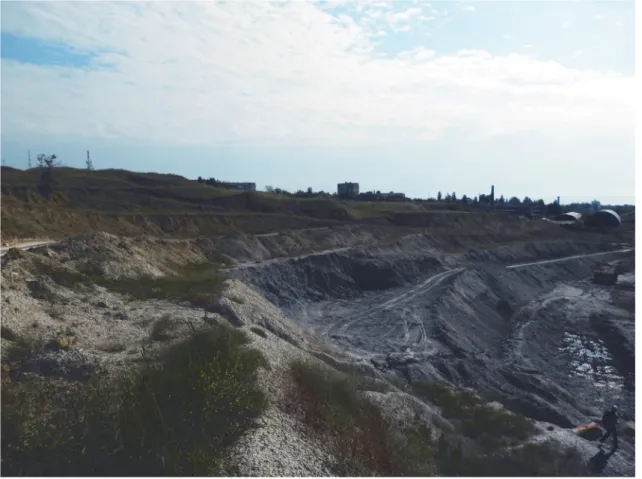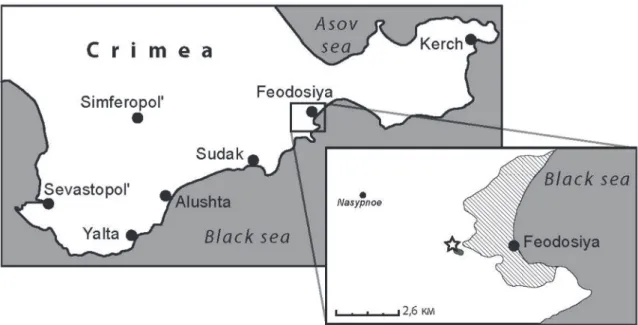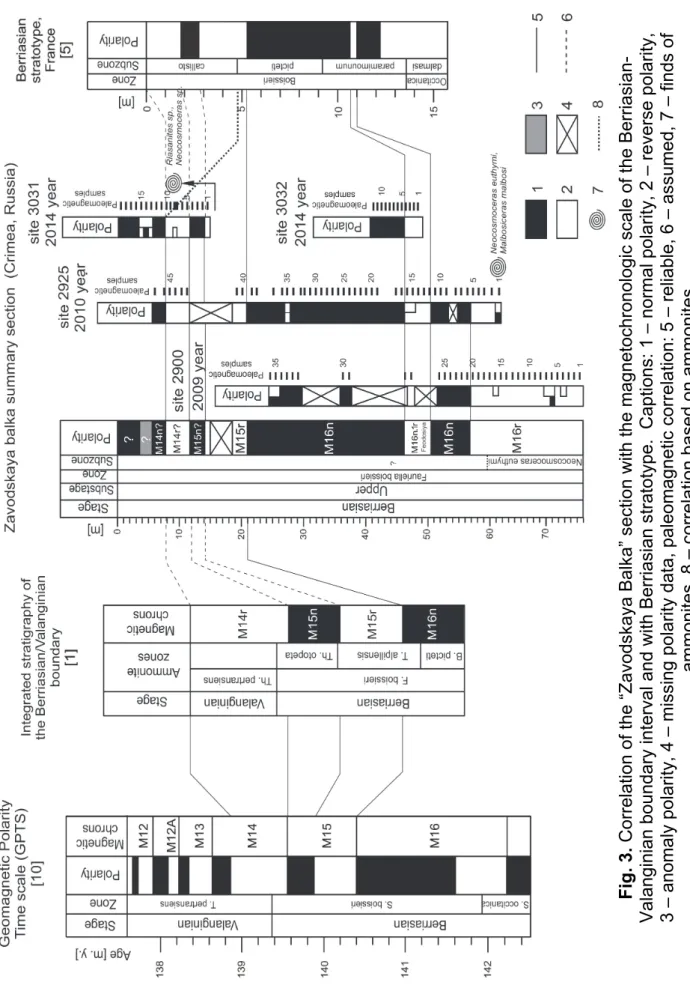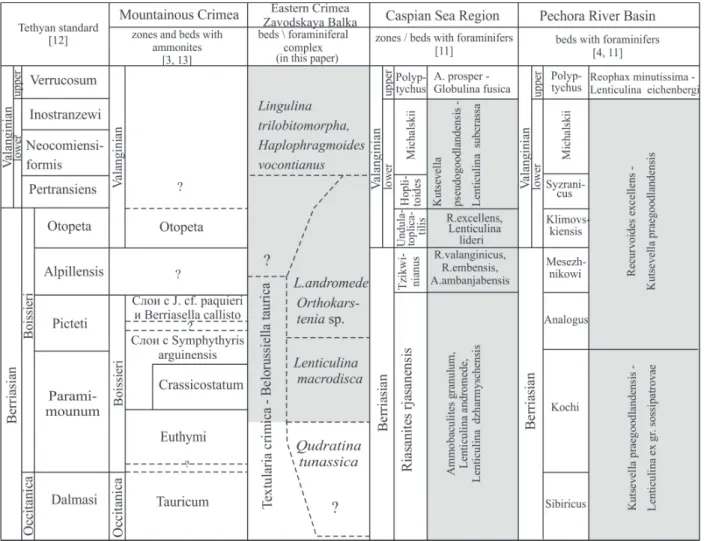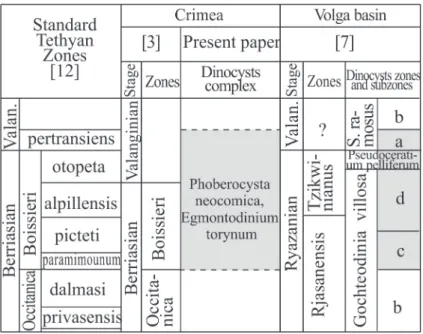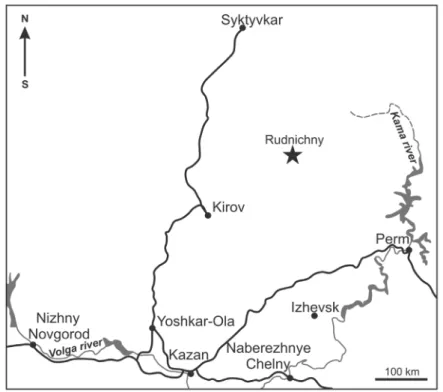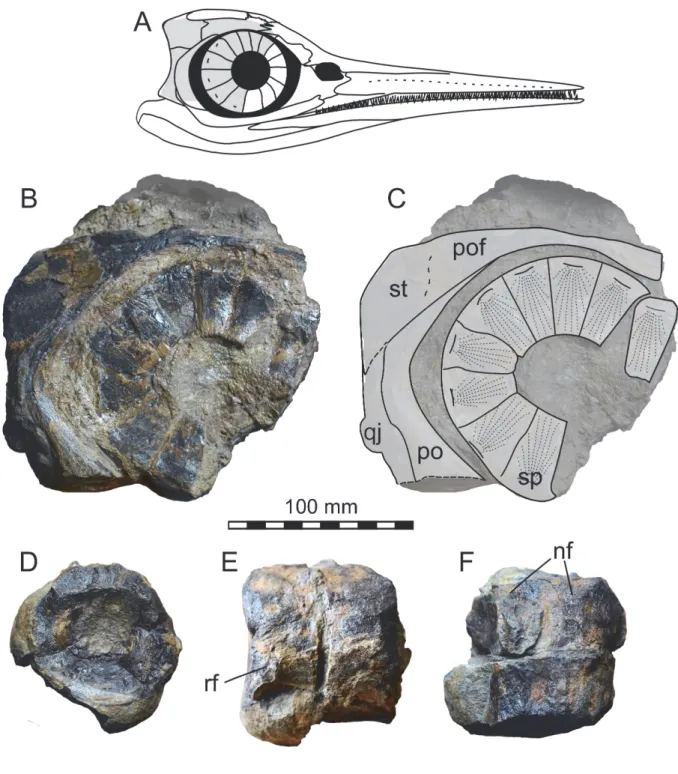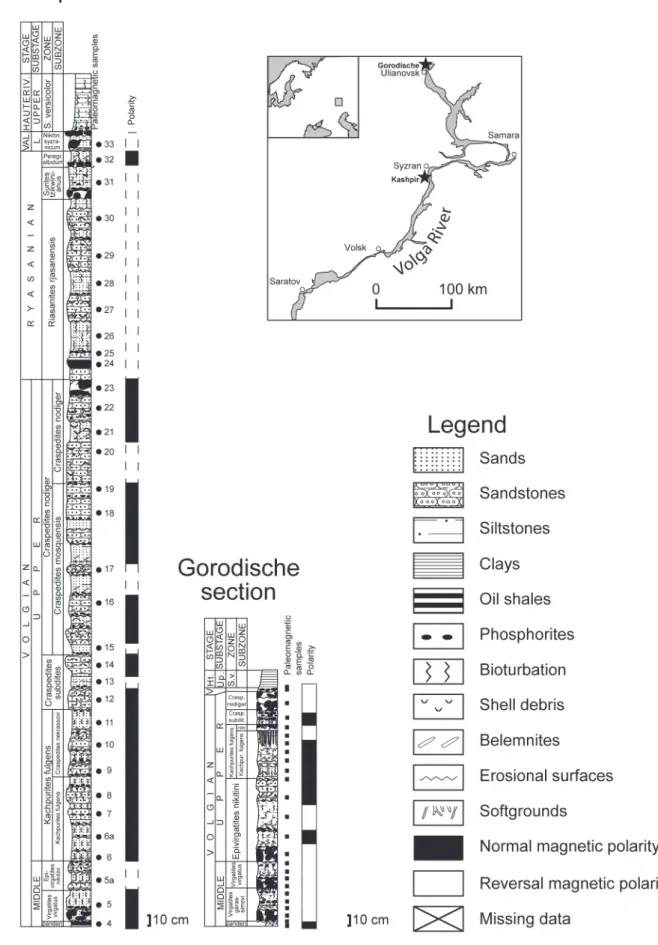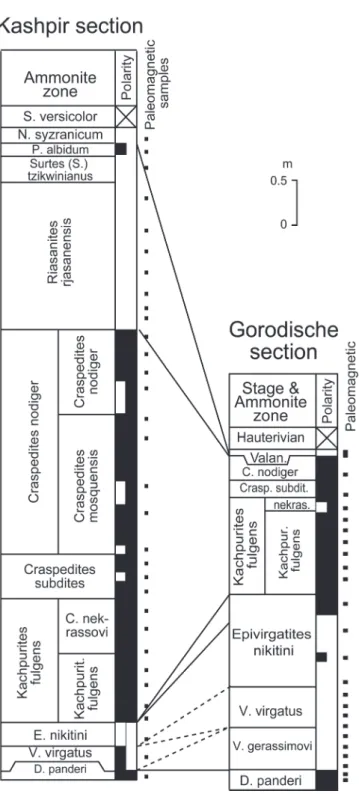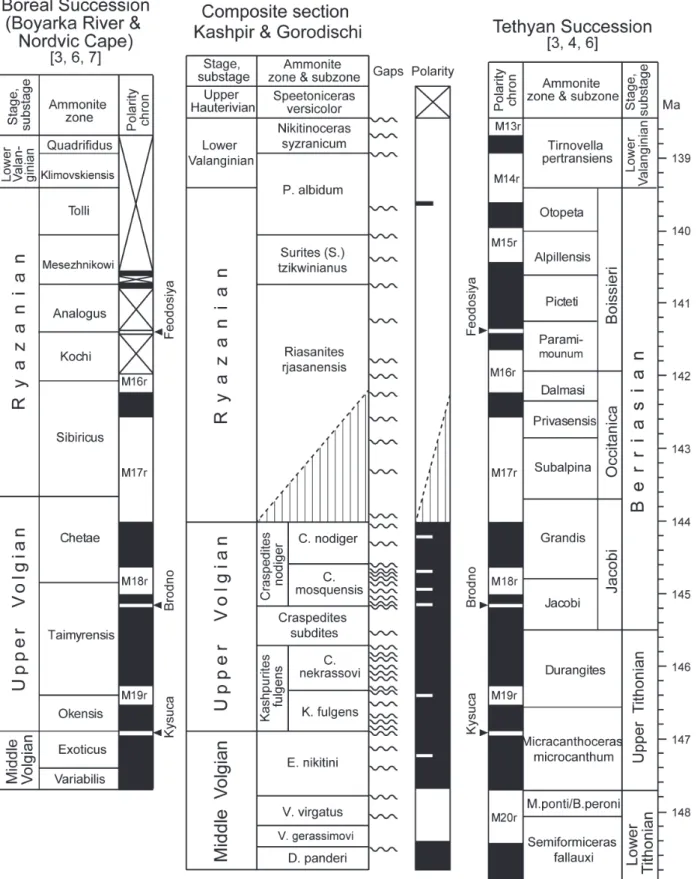The International Scientific Conference on the Jurassic/Cretaceous
boundary
Proceedings volume
September 7‐13, 2015 Samara, Russia
Commission on the Cretaceous System, ISC of Russia Commission on the Jurassic System, ISC of Russia
LLC “SamaraNIPIneft”
Samara State Technical University Samara State University, Geological Faculty
Geological Institute of RAS
Institute of Ecology of Volga River Basin of RAS Trofimuk Institute of Petroleum Geology and
Geophysics, SB RAS Saint-Petersbourg State University Geological Faculty, Lomonosov Moscow State
University
Отпечатано в типографии «Кассандра»
445061, Тольятти, ул. Индустриальная, д. 7; тел./факс (8482) 57‐00‐04: kassandra1989@yandex.ru (Адрес для корреспонденции: 445035, г.Тольятти, до востребования)
Подписано в печать с оригинал‐макета 25.08.2015 Формат А4. Гарнитура Ариал.
Бумага офсетная. Печать оперативная.
ББК 26.323
The International Scientific Conference on the Jurassic/Cretaceous boundary.
September 7-13, 2015, Samara (Russia). – Togliatti: Kassandra, 2015. – 96 p.
The present volume compiles short papers with new data on the Jurassic-Cretaceous boundary strata and their fauna of different regions of Russia (Volga region, Siberia, Crimea, Primorye) and of North America. Most papers are devoted to problems of biostratigraphy and paleontology of marine animals and their trace fossils. Besides this, some data on magnetostratigraphy, interregional correlations, history of defining J/K boundary in the Decisions of ISC, and eoomic value of the interval.
For geologists, paleontologists, stratigraphers, students of geological and geographical profiles.
Responsible editors: E.Yu. Baraboshkin, D.E. Bykov
Editorial board: M.A. Rogov, A.Yu. Guzhikov, V.V. Arkadiev, V.V. Gusev, A.A. Konovalova Technical editor: A.P. Ippolitov
Layouts: A.P. Ippolitov
English translation of papers by V.V. Efimov, I.A. Meleshin and E.L.Vasileva: A.P. Ippolitov
© the authors, 2015
© Samara State Technical University, 2015
© Оформление обложки. Издательство «Кассандра», 2015 ISBN 978-5-91687-161-6
Международная научная конференция по проблеме границы юрской и мело- вой систем. 7-13 сентября 2015 г., г.Самара (Россия): Материалы совещания. – Тольятти: Издательство «Кассандра», 2015. – 96 с.
В сборнике опубликованы новые данные о пограничных отложениях юры и мела различных регионов России (Поволжье, Сибирь, Крым, Приморье) и Северной Америки. Большинство работ посвящено био- стратиграфии и палеонтологии морских животных и следов их жизнедеятельности. Кроме того, приво- дятся сведения о магнитостратиграфии, межрегиональной корреляции, истории проведения границы юры и мела в постановлениях МСК, и экономической важности этого интервала.
Сборник представляет интерес для геологов, палеонтологов, стратиграфов, студентов геологиче- ского и географического факультетов.
Ответственные редакторы: Е.Ю. Барабошкин, Д.Е. Быков
Редакционная коллегия: М.А. Рогов, А.Ю. Гужиков, В.В. Аркадьев, В.В. Гусев, А.А. Коновалова Технический редактор: А.П. Ипполитов
Верстка: А.П. Ипполитов
Перевод статей В.В. Ефимова, И.А. Мелешина, Е.Л. Васильевой: А.П.Ипполитов
PREFACE
The Jurassic/Cretaceous is the only system boundary within the Phanerozoic, which still has debatable position. Moreover, according to different paleobiogeographical ground, International and national stratigraphic scales use different units for the boundary interval. Numerous conferences, symposiums and working group meetings has not brought the stratigraphers to any consensus on opinions yet.In addition, much new data has been accumulated, and is still being acumulating, making us taking some decision. Papers providing such data are put together in the present volume.
Important data are provided in the papers, presenting new interpretations on the Boreal-Tethyan correlation in the Pacific region. They are based on a complex magneto- and biostratigraphic (ammonites, foraminifera, palynology, ichnofossils) study of the sections located in Primorye (A.Yu. Guzhikov et al.; E.Yu. Baraboshkin, E.E. Baraboshkin) and revision of the buchiid succession in Northern California (V.A.
Zakharov).
Many papers are devoted to the re-study of classic sections in the Volga area, including Kashpir and Gorodischi sections, which are planned to be visited during the field excursions. For these sections, new data on bio- and magnetostratigraphy (E.Yu.
Baraboshkin et al.; V.P. Morov), and on new finds of fossil vertebrates (V.M. Efimov;
I.A. Meleshin) are provided. For Kashpir section, data on belemnites and bivalves are presented (O.S. Dzyuba, O.S. Urman, B.N. Shurygin). There is some interesting information on the stratigraphy of Jurassic-Cretaceous boundary strata in the sections along the Menya river (А.Y. Berezin), and on finds of marine reptiles from the Kirov region (M.S. Arkhangelsky, N.G. Zverkov).
A number of papers is based on materials from Crimea. The boundary interval of Berriasian and Valanginian in section near Feodosya is studied using integrative approach (ammonites, foraminifera, ostracods, palynology, magnetostratigraphy; V.V.
Arkadiev et al.). Unusual find of a belemnite of South American origin is described from the Berriasian of Central Crimea (A.P. Ippolitov, B. Desai, V.V. Arkadiev), and of Jurassic-like Pliosaurus – from the Valanginian of south-west Crimea (N.G. Zverkov).
Finally, one paper is devoted to a revision of high-Boreal Late Volgian ammonites from the Nordvik section (M.A. Rogov, A.S. Alifirov, A.E.Igolnikov).
One cannot forget that any scientific research, held over the Jurassic-Cretaceous boundary interval, will be reflected on different aspects of geological practice – mapping, based on unit boundaries, validated by the Interdepartmental Stratigraphic Commitee, mineral resources exploration, qualification of young geologists. These problems are discussed by N.L. Erofeeva & V.V. Gusev and by E.L. Vasileva.
The present volume probably will not solve the problem of the Jurassic- Cretaceous boundary, but let us make a new step in this direction.
E.Yu. Baraboshkin
THE ROLE OF GEOLOGY IN SOCIAL AND ECONOMIC DEVELOPMENT OF THE SAMARA REGION
Erofeeva N.L.*, Gusev V.V.**
*Subsurface Management Department “Samaranedra”; Samara, Russia
**Samara State Technical University; Samara, Russia
This meeting is dedicated to the Jurassic and Cretaceous boundary stages and their equivalents in the Boreal paleogeographic Realm - the Volgian and the Rhyazanian Stages. These seemingly purely scientific issues directly affect the development of the mineral resource base of the region. Their decision is related to the accuracy of geological maps, using for the evaluation of mineral resources. The state of the mineral resource base, in turn, influences the economic development of any region.
The well-known Kashpir oil shale field is developed in the Volgian deposits of the Samara Region, and Volgian, Ryazanian and Valanginian deposits contain phosphorites. The most famous is Kashpir oil shale field, which is under development since 1920. Its reserves are estimated at 11.5 billion tons; it is one of the largest deposits of oil shale. Initially these shales were used as fuel for power stations and boilers, and later as raw material for the chemical industry - getting medical ihtiola, phenol, benzene, toluene, thiophene, and other substances, many of which can not be obtained from any other raw materials. The phosphorites were mined in past in Kashpir during the 50th - 60th. Their reserves are 7 million tons here, although now their production is not economically effective.
Other natural resources which have significant economic value are subsurface water of drinking quality and mineral waters, building and silicate sands, clays (aggloporite, high-melting, brick and tegular, ceramsite), gypsum, carbonates (building stone, glass materials), native sulfur, bitumen and bituminous material. One of the major mineral resources of the region is hydrocarbon crude, which includes oil, gas (dissolved and free), condensate, natural bitumens. condensation product and solid bitumen. Currently, Samara region has considerable reserves and is among the main oil producing and refining regions of the country. The ratio of oil reserves of the Samara region corresponds to about 1.5%, while the ratio of oil-extracting overland Russia of the Samara region equals 3.0%.
A purposeful examination of oil and gas content of the earth depths of Samara region started in 1929. The first oil fields were discovered in 1936 (Syzranskoe) and in 1937 (Yablonevyi Ovrag). In 1940 on the results of Craelius core drilling geologists began to develop Kalinovskoe gas-and-oil field. During the World War II Zaborovskoe, Gubinskoe, Strelnikovskoe, Karlovo-Sytovskoe, Zolnenskoe and some other fields were discovered. The landmark event of that time was the discovery of Devonian oil in 1944 on the Yablonebskoye field. This discovery happened to be the biggest event in the petroleum branch of our country and it justified the extension of exploration works of oil finding in the Devonian sediments in other regions of Ural and Volga region. Later some fields with large reserves were discovered, such as Muhanovskoe, Dmitrievskoe,
EROFEEVA, GUSEV
Radaevskoe, Pokrovskoe, Kuleshovskoe, Novo-Zaprudnenskoe and others.
Commencement of these fields ensured a rapid growth of oil extraction and in 1957 their daily production rate exceeded that of the oldest oil field in Baku. Thus, the Samara region ranked third in the country according to the level of oil extraction.
By the present time 334 oil-and-gas fields have been discovered within the Samara region and most of them are being developed at the moment. Only 10 % of hydrocarbon reserves are not subject to development as they are located in undeveloped reserves, suspended reserves, in reserves which are being prepared for development or in places which are under exploration. Besides, the Samara region possesses long-range resources of oil of the category C3 (to the number of 215 million tons) and inferred resources of oil by the category D1 (to the number of 735 million tons). For the short-term the average annual volume is anticipated to reach 15-16 million tons. Thus, oil extraction in the samara region will continue for the next 34-40 years upon condition of a full examination and exploration of oil resources.
The main oil production enterprise of the region is still JSCo “Samaraneftegaz”.
As far as the majority of oil fields have been developed for several decades, the medium reserves depletion of the enterprise is 78.3% and the medium water cut is 84.5%. It is reasonable, that the level of extraction of exploited for a long time fields has to decrease gradually. But due to active implementation of innovative technologies and bringing into service overlooked fields, “Samaraneftegaz” continues to ramp up oil production (2005 – 9.5 mil tons, 2014 –11.2 mil tons).
As the analysis of materials from the develop reserves has shown, oil reserves growth continues even after 40 and 50 years from discovery of the fields. For example, on Syzranskoye field during the 55th year of development the growth of 60 000 tons was achieved (1,77% of the initial reserves as on 01.01.1998). On Yablonevoye field during the 52nd year of exploitation the growth was 20.8% higher than the initial estimate. All in all, the analysis of 60 fields has shown the growth of: 6 fields with more than 50 years run life, 22 fields with 40-50 years run life, 54 fields with 30-40 years run life, 74 fields with 20-30 years run life. So, owing to their natural features as well as methodological and physical capabilities of reserve calculation, even very old fields can provide the reserves growth. Let us hope that the fields which were discovered at a later time will also come into the category of “old” fields and will serve as a source of the reserve growth but with a less volume.
There are twenty-two oil production enterprises in the Samara region besides
“Samaraneftegaz”. Over a period of 2005-2014 the volume of produced oil increased from 10.7 mil. tons to 15.7 mil. tons. What is more, natural rate of growth is observed among small companies. In 2005 the extent of production of small companies was 1.0 mil. tons (7.7 %), while in 2014 it was 4.52 mil. tons or 28.8% of the whole extent of production within the region.
The increase of oil production enterprises and improvement of tax system have enabled a systematic growth of earnings into both federal and regional budgets in the form of mineral replacement tax. The federal tax increased from 36.0 mil. roubles in 2010 to 68.2 mil. roubles in 2014. The regional tax reached 70.6 mil. roubles in 2014.
Because of the increase of the reserves-to-resources ratio in the region as well as the exploration maturity, the level of supply is decreasing naturally from 18.9 mil. tons in 1946-1960 to 0.1 mil. tons in 1999-2015 per each field. Previously these fields (mainly, with reserves difficult to recover) have not been brought into development for
costs reasons. The emergence of new special space planning solutions and operation practices, as well as the stable growth of prices for hydrocarbon made it possible to develop these fields in the present. According to the specialists’ research, the reserves of some small and smallest fields are regarded as active and can practically be involved into development.
It is noteworthy that on the territory of our region even the deposits with the reserves of 100 000 tons are commercially viable. This is because of the high density of resources within a tight territory, high quality of the oils and relatively small cover thickness (75% of reserves occur at a depth of less than 3000 m), well-developed infrastructure, closeness to the consumer market and the objects of refining and convenient transfer system with regard to Europe.
The geological exploration of the recent years has shown the following: from 6 to 13 new fields are discovered every year, there is an annual reserves growth which 2-4 times exceeds the extraction (25-50 mil. tons), there is an annual increase of oil extraction (2005г. – 10.7 mil. tons, 2014г. – 15.7 mil. tons). All of the above proves that the system licensing of mineral resource use stimulates the development of the oil branch. This task is successfully performed by the surface management department called “Samaranedra”. This body coordinates the activities of all the geological and mineral extracting enterprises, works out a strategy and tactics of the geological study of subsurface resources, provides the state licensing system of mineral resource use, invites a tender for the right of mineral resource use.
In 1980s there was a school of thought that oil and gas reserves had been worked out for 80% and later the production of hydrocarbons would decrease.
Especially as the production level was 8.8 mil. tons in 1996 and 7.7 mil. tons in 1999.
But those prognoses did not prove to be right. Due to the implementation of new technologies, the production level has increased to 15 mil. tons per year.
Apart from the regular on spec oil the resources of which have not been explored to a fully extent yet, our region possesses non-conventional resources of hydrocarbon such as high-viscosity oil, native bitumen, bituminous shale, light tight oil which are to be explored in the future. Search and prospecting of new fields (including nonconventional ones) require skilled workforce.
The value of fresh ground water remains to be high. Moreover, in the context of a growing deficiency of the fresh water of drinking quality its value is increasing. The general demand of the Samara region in drinking quality water for the short-term is 2984,41 thousand cubic meters per day. Search and prospecting of new groundwater deposits require professional geological organizations.
By common commercial minerals are meant subsurface rock and minerals which are mainly used as building materials in their native state or with inessential processing and clearing aimed mostly at local need-satisfaction. Their exploration also requires geologists.
Nowadays for successful prospecting and effective development of identified fields we need to have qualified personnel.
Degree program 130304 “Oil and Gas Geology” was established at Federal State Budgetary Educational Institution of Higher Vocational Education “Samara State Technical University” (one of the oldest university of the Povolzhie region with its own developed traditions and a huge history) in 2007 under order of the users of
EROFEEVA, GUSEV
subsurface resources of the Samara region. In 2012 the first mining engineers got their diplomas of this degree program. The graduates – mining engineers having a degree in 130304 “Oil and Gas Geology” – master the high-effective up-to-date methods of information processing and they are able to create a geological model of a field. There is a demand for such specialists at geological departments of huge oil and gas companies, design and research institutions, Oil/Gas Production Division, Management of Drilling Work and other geological and oil enterprises.
Because of the change in the nomenclature of degree programmes and the implementation of a new educational standard FSES-3, since 2011 students have been enrolled to study the degree program 130101 “Applied Geology” (specialization
“Oil and Gas Geology”) and they graduate with a qualification “specialist”.
Now it can be seen that the economy of the Samara region largely depends on the effectiveness of usage of the mineral resources base, replacement of which requires highly qualified specialists in geology.
REFERENCES
1. Gilaev, G.G. (2014) Oil Field Development of the Samara region: from practice to strategy. Neft. Gaz.
Novatsii.
2. Hasaev, G.R., Prigoda, N.N. (2012) Economic Potential of the Mineral Resources of the Samara Region. SSEU.
3. Mineral Resources Base of the Samara Region: Status and Future Development (2006). Agni.
OF THE UPPER BERRIASIAN SECTION “ZAVODSKAYA BALKA” (EASTERN CRIMEA, FEODOSIYA)
Arkadiev V.V.*, Guzhikov A.Yu.**, Savelieva J.N.***, Feodorova A.A.***, Shurekova O.V.***, Bagaeva M.I.**, Grishchenko V.A.**, Manikin A.G.**
*Saint-Petersburg State University, Saint-Petersburg, Russia
**Saratov State University, Saratov, Russia
***FGU NPP “Geologorazvedka”, Saint-Petersburg, Russia arkadievvv@mail.ru
Abstract: The results of bio- and magnetostratigraphic investigations of the uppermost Upper Berriasian in Zavodskaya Balka section (Feodosiya, Crimea) are presented. The ammonites of the genus Riasanites (Ammonoidea) were found in this section for the first time. The studied section corresponds to Boissieri Zone (Crassicostatum Subzone) of standard Tethyan scale by ammmonites. Data on foraminifera and dinocysts indicate Late Berriasian – Early Valanginian age.
Magnetostratigraphic data shows that the section resembles the uppermost Berriasian - lowermost Valanginian interval (Otopeta Subzone and Pertransiens Zone).
Key words: Biostratigraphy, Berriasian, Valanginian, ammonites, foraminifers, ostracods, dinocysts, magnetostratigraphy, geomagnetic polarity, magnetic Chrons, correlation, Mountainous Crimea.
The well known section of Sultanovka Formation is located in the clay quarry
«Zavodskaya Balka» at the northern outskirt of Feodosiya (Eastern Crimea). By ammonites, the age of formation is considered to be Berriasian [3] (Fig. 1, 2). Bio- and magnetostratigraphic studies for this section were carried out by V.V. Arkadiev, A.Yu.
Guzhikov, A.G. Manikin and V.A. Perminov in 2009. Among results of these studies, there was a discovery of ammonites Neocosmoceras euthymi (Pictet), Fauriella cf.
boissieri (Pictet), Malbosiceras malbosi (Pictet) in the upper part of the succession.
This assemblage is characteristic for Neocosmoceras euthymi Subzone of the Mountainous Crimea [2] corresponding to standard Tethyan Malbosiceras paramimounum Subzone of Boissieri Zone [12].
The main result of the fieldwork in 2010 was the paleomagnetic characteristic of the succession. On this base the existence of reversed polarity epoch during Chron M16n (the M16n.1r Subchron or “Feodosiya”) was stated and trans-regional correlations of the Upper Berriasian were carried out [2, 6].
New stratigraphic units - beds with ostracods Robsoniella obovata and the beds with dinocyst Phoberocysta neocomica [3] - were established as a result of micropaleontological investigation.
Ammonites classified as Riasanites by shell shape and distinctive ribbing (Plate
ARKADIEV ET AL.
Fig. 1. Location of the Upper Berriasian “Zavodskaya Balka” section
Fig. 2. Quarry “Zavodskaya Balka” showing the Upper Berriasian – Lower Valanginian strata.
I), were discovered in 2014 in the upper part of the section, 40 m above the Neocosmoceras euthymi (Pictet) finds. These ammonites were not determined up to the species level because of poor preservation. In addition, a fragment of a large ammonite Neocosmoceras sp. was found. These two ammonites are the first finds of Riasanites in the Eastern Crimea. Previous records were made in the sucessions of Central Crimea only [3], where Riasanites crassicostatum Subzone can be distinguished above Neocosmoceras euthymi Subzone.
Paleontological (ammonites) and paleomagnetic data obtained from «Zavodskaya Balka» section are ambiguous (Fig. 3). Riasanites is unknown from Otopeta Subzone (Zone), but is known from three stratigraphic levels within Boissieri Zone [14] on the North Caucasus (Uruch River Basin), moreover, the uppermost level corresponds to Berriasella picteti Subzone on the South-East France. Riasanites was not recorded from the overlying beds with Berriasella callisto and Jabronella paquieri at the Caucasus. Formerly Riasanites crassicostatum Subzone of Central Crimea was correlated to the lower part of Berriasella picteti Subzone of Boissieri Zone [3]. On the Russian Plate species belonging to Riasanites characterize Riasanites rjasanensis Zone [8], which is correlated to Occitanica and Boissieri Zones [9], or only to Boissieri Zone [3]. On the other hand, obtained paleomagnetic data indicate that the uppermost part of Zavodskaya Balka section is equivalent of the Otopeta Zone in Western Europe by age [1]. Consequently, wider stratigraphic range for the genus Riasanites should be recognized. The question is still open until the species of this genus will be found along with the characteristic ammonites of the Otopeta Subzone. Foraminiferal assemblage with Lingulina trilobitomorpha, Haplophragmoides vocontianus established in the upper part of the section is correlated by A. Fedorova to the Valanginian of standard Tethyan scale (Fig. 4). It points on the presence of intermediate from Berriasian to Valanginian deposits.
The ostracod assemblages show some similarities with the Middle Berriasian – Valanginian complexes. Upper part of the studied section is well correlated to Boissieri Zone of the Berriasian and Pertransiens Zone of the Lower Valanginian of Tethyan standard on the base of dinoflagellate data and this assumption corresponds well with paleomagnetic data.
This study was supported by RFBR grant no. 14-05-31152 and the RF Ministry of Education and Sciences in the scientific field (project 1757).
Plate I
Ammonites from the Upper Berriasian Boissieri zone of the “Zavodskaya Balka”
section
Fig. 1-5 – Riasanites sp., 1 – no 1/409, side view, 2 – no 2/409, side view, 2a, 2b, 3 – no 3/409, side view, 3a, 3b, 4 – no 4/409, side view, 4a, 4b, 5 – no 5/409, side view, 5a, 5b.
Fig. 6 – Neocosmoceras sp., no 7/409, side view.
ARKADIEV ET AL.
Plate I
Fig. 3. Correlation of the “Zavodskaya Balka” section with the magnetochronologic scale of the Berriasian- Valanginian boundary interval and with Berriasian stratotype. Captions: 1 – normal polarity, 2 – reverse polarity, 3 – anomaly polarity, 4 – missing polarity data, paleomagnetic correlation: 5 – reliable, 6 – assumed, 7 – finds of ammonites, 8 – correlation based on ammonites.
ARKADIEV ET AL.
Fig. 4. Correlation of the beds with foraminifers of Eastern Crimea and Berriasian- Valanginian zones and beds of the Caspian Sea Region and the Pechora River Basin.
Fig. 5. Correlation of the beds with dinocysts with standard scale and zones of the Volga Basin. Gray filling shows the stratigraphic ranges of similar
dinocyst assemblages.
REFERENCES
1. Aguado, R., Company, M., & Tavera, J. M. (2000). The Berriasian/Valanginian boundary in the Mediterranean region: new data from the Caravaca and Cehegı́n sections, SE Spain. Cretaceous Research, 21(1), 1-21.
2. Arkadiev, V.V., Bagaeva, M. I., Guzhikov, A. Yu., Manikin, A. G., Perminov, V. A., & Yampolskaya, O.
B. (2010). Bio- and magnetostratigraphic characteristics of the Upper Berriasian «Zavodzkaya balka» section (East Crimea, Feodosiya). Vestnik of Saint-Petersburg University. Series 7. Geology.
Geography. 2, 3-16. [in Russian].
3. Arkadiev, V.V., Bogdanova, T.N., Guzhikov, A.Yu., Lobacheva, S.V., Myshkina, N.V., Platonov, E.S., Savelieva, Yu.N., Shurekova, O.V., & Yanin, B.T. (2012). Berriasian of Mountain Crimea. St.- Petersburg: Lema. [in Russian].
4. Bystrova, V.V. (1990). Particularity of distribution of foraminiferal assemblages from the Neocomian deposits of Pechora and Sysola rivers. Bio- and lithostratigraphy of Mesozoic oil and gas regions of the USSR, 156-163. [in Russian].
5. Galbrun, B. (1985). Magnetostratigraphy of the Berriasian stratotype section (Berrias, France). Earth and planetary science letters, 74(1), 130-136.
6. Guzhikov, A., Bagayeva, М., & Arkadiev, V. (2014). Magnetostratigraphy of the Upper Berriasian
“Zavodskaya Balka” section (East Crimea, Feodosiya). Volumina Jurassica, 12(1), 175-184.
7. Harding, I. C., Smith, G. A., Riding, J. B., & Wimbledon, W. A. (2011). Inter-regional correlation of Jurassic/Cretaceous boundary strata based on the Tithonian-Valanginian dinoflagellate cyst
biostratigraphy of the Volga Basin, western Russia. Review of Palaeobotany and Palynology, 167(1), 82-116.
8. Mitta, V. V. (2008). Ammonites of Tethyan origin from the Ryazanian of the Russian Platform: genus Riasanites Spath. Paleontological Journal, 42(3), 251-259.
9. Mitta, V. V. (2007). Ammonite assemblages from basal layers of the Ryazanian Stage (Lower Cretaceous) of Central Russia. Stratigraphy and Geological Correlation, 15(2), 193-205.
10. Ogg J.G., Hinnov L.A. (2012). Cretaceous. In F. Gradstein, J.G. Ogg, M.D. Schmitz & G.M. Ogg (Eds.) The Geologic Time Scale 2012 (pp.793-853). Elsevier.
11. Sokolov, B.S. (Ed.). (1991). Practical handbook on the miсrofauna of the USSR. V. 5. Foraminifers of Mesozoic. Leningrad: Nedra. [in Russian].
12. Reboulet, S., Szives, O., Aguirre-Urreta, B., Barragán, R., Company, M., Idakieva, V., ... & Tavera, J. M. (2014). Report on the 5th International Meeting of the IUGS Lower Cretaceous Ammonite Working Group, the Kilian Group (Ankara, Turkey, 31st August 2013). Cretaceous Research, 50, 126-137.
13. Savelieva, J., Feodorova, A., Shurekova, O., & Arkadiev, V. (2014). Integrated palaeontological characteristics (ammonites, ostracods, foraminifers, dinocysts) of the Berriasian deposits of central Crimea. Volumina Jurassica, 12(1). 129-162.
14. Sey, I.I., & Kalacheva, E.D. (2000). Ammonites. The Berriasian of the North Caucasus (Urukh section) (pp.20-31). St.-Petersburg: VNIGRI. [in Russian].
A VALANGINIAN ICHTHYOSAUR FROM KIROV REGION (RUSSIA) SUPPORTING THE JURASSIC-CRETACEOUS BOUNDARY
CROSSING FOR ICHTHYOSAURS
Arkhangelsky M.S.*, Zverkov N.G.**
*Saratov State Technical University; Saratov State University; Saratov, Russia
**Lomonosov Moscow State University; Moscow, Russia paleozoo@gmail.com; zverkovnik@rambler.ru
Abstract: Here we gave a brief description of an ichthyosaurian remains from the Lower Valanginian of the European Russia (Kirov region) referable to the family Ophthalmosauridae Baur, 1887. The record of ichthyosaurs from the Berriasian–
Barremian interval is extremely limited so even fragmental remains are of great interest. This finding confirms the assumption that the Jurassic–Cretaceous boundary extinction event had a negligible effect on ichthyosaurs [9].
Key words: Ichthyosauria, Ophthalmosauridae, Cretaceous, Valanginian, Russia.
Introduction. Berriasian-Valanginian marine reptiles, inter alia ichthyosaurs, are quite rare all over the world, as repeatedly pointed out by many authors [2, 9, 13].
Considerable part of the ichthyosaurian remains from this stratigraphic interval for a long time was defined only as Ichthyosauria indet., Thunnosauria indet., Ophthalmosauridae indet. and Platypterygiinae indet. [1, 5, 12, 18]. Only a few platyperygiines from the Berriasian-Valanginian were identified at genus and species level: Aegirosaurus sp. (Valanginian, southeastern France) [8], 'Platypterygius' hauthali (Huene, 1922) (Valanginian–Hauterivian, Chile) [15, 19] and Caypullisaurus bonapartei Fernandez, 1997 (Tithonian–Berriasian, Argentina) [6, 19]. It was previously believed that the representatives of the subfamily Ophthalmosaurinae Baur, 1887 became extinct at the Jurassic–Cretaceous boundary. In recent years, it has been found that ophthalmosaurines did not disappear in the Late Jurassic and continued to exist in the Early Cretaceous [8-10]. This was evidenced by the recently described remains of Acamptonectes densus Fischer et al., 2012 (upper Hauterivian, Germany) [9], Leninia stellans Fischer et al., 2013 (Lower Aptian, Western Russia) [10], cf. Ophthalmosaurus (Uppermost Tithonian to Berriasian, England) [9] and indeterminate ophthalmosaurines in Cambridge Greensand (Uppermost Albian, England) [11].
As such, a partial ichthyosaur skull and two associated vertebrae from the Valanginian are of considerable interest. The material is deposited at the Vernadsky State Geological Museum of Russian Academy of Scienсes, Moscow (specimen SGM 1574-02, 1574-03). Remains belong to a medium-sized ichthyosaur. The scarcity of the material does not permit to unambiguously identify it and conduct a detailed comparative analysis. The presence of a relatively large orbit and a narrow postorbital bar demonstrates similarity with several ophthalmosaurines - Ophthalmosaurus Seeley, 1874, Paraophthalmosaurus Arkhangelsky, 1997, as well as the peculiar
platypterygiines Aegirosaurus Bardet et Fernandez, 2000 and Sveltonectes Fischer et al., 2011. Thus, we conservatively identify the remains as a small form belonging to the family Ophthalmosauridae.
The history of discovery and geological settings. The bones were found in Vyatka phosphorite mine, located in Verkhnekamsk district of Kirov region. Mine was organized in 1915, but the mechanized mining operations were started here only in 1930. The find was made in August, 1926, obviously due to the manual artisanal mining process of phosphorite recovery. Currently the mine is not functional.
According to the label, the remains were found in Pyankovka branch that was situated near the village Pyankovka, now a part of Rudnichny township (Fig. 1).
Fig. 1. Map showing the discovery site of SGM SGM 1574-02 Ophthalmosauridae indet. Locality is marked with an asterisk.
The bones were removed from the main phosphorite seam by I. Galin in August, 1926 and later (25.03.1927) they were delivered to Geological Cabinet of Moscow State University. Now the bones are deposited at V.M. Vernadsky State Geological Museum of RAS. According to the literature, the mine was a part of the Vyatka-Kama phosphorite deposits. It is located 150-200 km north-east from Kirov. It stretches from south-west to north-east between the rivers Vyatka and Kama for 120 km and was 30- 50 km in width. The phosphorite deposit is confined to a broad trough formed by the Jurassic, Cretaceous and Quaternary sediments. The main phosphorite layer refers to the lower Valanginian Nikitinoceras hoplitoides Zone [3, 14]. The mined seam lies almost horizontally, folded by black and dark brown phosphorite nodules up to 10 cm, at the top - up to 20-30 cm, are firmly concentrated in the quartz-glauconite sands. The overburden is represented by the Hauterivian dense, micaceous, sandy clays
ARKHANGELSKY, ZVERKOV
interbedded with thin layers of quartz-glauconite sands and phosphorite gravel. In the clays, eluvial-diluvial and alluvial loams and sands commonly occur. Thickness of phosphorite horizon is 0.5-1.7 m. The depth of the reservoir is from 1-2 m to 60-80 m [16, 17].
SYSTEMATIC PALAEONTOLOGY Ichthyosauria Blainville, 1835 Neoichthyosauria Sander, 2000
Thunnosauria Motani, 1999 Ophthalmosauridae Baur, 1887
Ophthalmosauridae indet.
Fig. 2
Description. Preservation of bones is poor. The orbit is large, oval in shape, slightly constricting posteriorly. It is incompletely preserved, its ventral and front edges are missing (Fig. 2A-C). Dorsally it is formed by the postfrontal, posteriorly by the postorbital. The postorbital is thin and gracile, slightly extended downward. The suture between the postfrontal and the supratemporal is undistinguishable. A small fragment of the quadratojugal is preserved.
The sclerotic ring is preserved in three dimensions, but partially broken. The diameter of the external area is 130 mm, the diameter of the aperture is 50 mm, as in the must larger taxon Caypullisaurus [10], suggesting a relatively large eye size for SGM 1574-02. Nine sclerotic plates are preserved, eight of them are in natural articulation. The sclerotic ring occupies the entire area of the orbit, which probably suggests SGM 1574-02 was a juvenile [7].
Two anterior caudal vertebrae are preserved (Fig. 2D-F). They are relatively elongated (length to height ratio - 0.43).
Material. State Geological Museum of RAS, SGM 1574-02, fragment of right half of skull related to the orbital area, sclerotic ring, SGM 1574-03, two anterior caudal vertebrae; Kirov region, Verkhnekamsk district, near the township Rudnichny, Vyatka phosphorite mine, Pyankovka branch; Lower Cretaceous, Lower Valanginian, Nikitinoceras hoplitoides Zone.
Conclusion. The studied remains may be identyfined as a representative of the family Ophthalmosauridae. Ichthyosaurian remains previously described from the Valanginian of Crimea [4] are also could be defined only as Ophthalmosauridae indet.
Thus, in the Valanginian the Russian Sea and adjacent water basins were inhabited by medium-sized ophthalmosaurids, most likely specialized on hunting for small soft- bodies nekton – fish and cephalopods. This finding confirms that ichthyosaurs successfully crossed the Jurassic-Cretaceous boundary and thereby further search for the Lower Cretaceous ichthyosaurs in Central Russia should yield positive results.
View of the fact that ichthyosaurs were not affected by the Jurassic-Cretaceous boundary extinction event [9], and their taxonomic composition appears to be the same in both the Upper Jurassic and early Early Cretaceous, they can not be regarded as stratigraphic indicators for the Jurassic-Cretaceous boundary at the current level of knowledge.
Acknowledgements. We thank I.A. Starodubtseva and V.B. Basova (V.M.
Vernadsky State Geological Museum of Russian Academy of Scienсes, Moscow) for their assistance during our study of the museum materials and V. Fischer (University of Oxford, UK) for valuable advices.
Fig. 2. Ophthalmosauridae indet. (SGM 1574-02, 1574-03): A – a position of the described fragment in the skull; B – fragment of the skull; C – interpretive outline;
D-F – anterior caudal vertebrae (SGM 1574-03) in anterior (D), lateral (E) and dorsal (F) views. Abbreviations: nf – neural arch facet, po – postorbitale, pof – postfrontale,
qj – qadratojugale, rf – rib facet, sp – sclerotic plate, st – supratemporale.
ARKHANGELSKY, ZVERKOV
REFERENCES
1. Arkhangelsky, M.S. (2001). On the historical sequence of Jurassic and Cretaceous ichthyosaurs.
Paleontological Journal, 35(5), 70–74.
2. Benson, R. B., & Druckenmiller, P. S. (2014). Faunal turnover of marine tetrapods during the Jurassic–Cretaceous transition. Biological Reviews, 89(1), 1-23. doi:10.1111/brv.12038
3. Dubeikovsky, S.G. (1971) Stages of Vyatka-Kama phosphorite deposits formation. Doklady Akademii nauk SSSR, 201(5), 1212–1213.
4. Efimov, V. M., & Komarov, V. N. (2010). New records of marine reptiles from the Lower Cretaceous of the Crimean Mountains. Proceedings of Higher Educational Establishments. Geology and
Exploration, 5, 79-82.
5. Ensom, P. C., Clements, R. G., Feist-Burkhardt, S., Milner, A. R., Chitolie, J., Jeffery, P. A., & Jones, C. (2009). The age and identity of an ichthyosaur reputedly from the Purbeck Limestone Group, Lower Cretaceous, Dorset, southern England. Cretaceous Research, 30(3), 699-709.
6. Fernández, M. S. (1997). A new ichthyosaur from the Tithonian (Late Jurassic) of the Neuquén Basin, northwestern Patagonia, Argentina. Journal of Paleontology, 71, 479-484.
7. Fernández, M. S., Archuby, F., Talevi, M., & Ebner, R. (2005). Ichthyosaurian eyes: paleobiological information content in the sclerotic ring of Caypullisaurus (Ichthyosauria, Ophthalmosauria). Journal of Vertebrate Paleontology, 25(2), 330-337.
8. Fischer, V., Clément, A., Guiomar, M., & Godefroit, P. (2011). The first definite record of a Valanginian ichthyosaur and its implications on the evolution of post-Liassic Ichthyosauria.
Cretaceous Research, 32(2), 155-163.
9. Fischer, V., Maisch, M. W., Naish, D., Kosma, R., Liston, J., Joger, U., ... & Appleby, R. M. (2012).
New ophthalmosaurid ichthyosaurs from the European Lower Cretaceous demonstrate extensive ichthyosaur survival across the Jurassic-Cretaceous boundary. PLoS One, 7(1), e29234. doi:
10.1371/journal.pone.0029234
10. Fischer, V., Arkhangelsky, M. S., Uspensky, G. N., Stenshin, I. M., & Godefroit, P. (2014). A new Lower Cretaceous ichthyosaur from Russia reveals skull shape conservatism within
Ophthalmosaurinae. Geological Magazine, 151(1), 60-70.
11. Fischer, V., Bardet, N., Guiomar, M., & Godefroit, P. (2014). High Diversity in Cretaceous Ichthyosaurs from Europe Prior to Their Extinction. PLoS ONE, 9(1), 1–26. DOI: 10.1371/
journal.pone.0084709
12. Green, J. P., & Lomax, D. R. (2014). An ichthyosaur (Reptilia: Ichthyosauria) specimen from the Lower Cretaceous (Berriasian) Spilsby Sandstone Formation of Nettleton, Lincolnshire, UK.
Proceedings of the Geologists’ Association, 125, 432–436. doi: 10.1016/j.pgeola.2014.08.007 13. Hornung, J.J., Sachs, S., & Kear, B.P. (2013). Sauropterygian fossils from the predominantly limnic–
brackish Bückeberg Formation (Berriasian–Early Valanginian, Early Cretaceous) of northwestern Germany – diversity, distribution, and palaeoecology. In Reitner, J., Yang, Qun, Wang, Yondong, &
Reich, M. (Eds.). Palaeobiology and Geobiology of Fossil Lagerstätten through Earth History. A joint conference of the „Paläontologische Gesellschaft“ and the „Palaeontological Society of China“, Göttingen, Germany, September 23–27, 2013, Abstract Volume (p. 75).
14. Kassin, N.G. (1928). General geological map of the European part of the USSR. Sheet 107. Vyatka- Slobodskoy-Omutninsk-Kai. Mémoires du Comitté géologique. Nouvelle série, 158, 1-268.
15. Pardo-Pérez, J., Frey, E., Stinnesbeck, W., Fernández, M. S., Rivas, L., Salazar, C., & Leppe, M.
(2012). An ichthyosaurian forefin from the Lower Cretaceous Zapata Formation of southern Chile:
implications for morphological variability within Platypterygius. Palaeobiodiversity and Palaeoenvironments, 92(2), 287-294.
16. Phosphorites of the Middle Volga Region (1969). Kazan: Izdatelstvo kazanskogo universiteta.
17. Polanin, V.A., Nezamutdinov, A.G., & Tamoikin, Yu.S. (1973). Phosphorite formation of the Vyatka- Kama basin. Kazan: Izdatelstvo kazanskogo universiteta.
18. Shultz, M. R., Fildani, A., & Suarez, M. (2003). Occurrence of the Southernmost South American Ichthyosaur (Middle Jurassic—Lower Cretaceous), Parque Nacional Torres del Paine, Patagonia, Southernmost Chile. Palaios, 18(1), 69-73.
19. Stinnesbeck, W., Frey, E., Rivas, L., Pérez, J. P., Cartes, M. L., Soto, C. S., & Lobos, P. Z. (2014). A Lower Cretaceous ichthyosaur graveyard in deep marine slope channel deposits at Torres del Paine National Park, southern Chile. Geological Society of America Bulletin, 126(9-10), 1317-1339.
ICHNOLOGY OF THE JURASSIC-CRETACEOUS BOUNDARY INTERVAL OF THE CHIGAN СAPE (VLADIVOSTOK REGION, RUSSIA)
Baraboshkin E.Yu., Baraboshkin E.E.
Lomonosov Moscow State University, Moscow, Russia ejbaraboshkin@mail.ru
Abstract: The results of the ichnological study of the Jurassic / Cretaceous boundary section of Chigan Cape are discussed.
Key words: Cretaceous, Jurassic, ichnology, trace fossils, Russian Far East.
We have studied the well-known Jurassic–Cretaceous Chigan section (Chigan Cape, Podiapolsky Town area, Vladivostok Region) with the group of geologists from Saratov and Saint Petersburg State Universities, and Far East Geological Institute FEB RAS in September 2014. The location, stratigraphy and sedimentology of this section are discussed in the paper of Guzhikov and others, this volume. The succession is represented by intensively bioturbated (bioturbation index of Droser and Bottjer = 5-6) lower shoreface muddy sandstones (Members 1-3 and 5: [3]) and non-bioturbated middle-upper shoreface sandstones (Member 4: [3]).
The variability of trace fossils is rather high within Schaubcylindrichnus - dominated ichnofabric. It contains Schaubcylindrichnus coronus Frey et Howard, 1981, Teichichnus isp., Thalassinoides isp., Ophiomorpha irregulaire Frey, Howard et Pryor, 1978, Phycosiphon incertum Fischer-Ooster, 1858, Rhizocorallium commune Schmid, 1876, Asterichnus lawrencensis Bandel, 1967, Bichordites monastiriensis Plaziat and Mahmoudi, 1988, Neonereites uniserialis Seilacher, 1960, N. biserialis Seilacher, 1960 and some non-identified taxa.
Ichnogenus Schaubcylindrichnus is the most common ichnofossil in the section.
It is typical of lower shoreface to offshore-transition zone [6] and has been interpreted as a funnel feeder such as enteropneust polychaetes [7] or passive carnivore trace [6].
The number of tubes per sheaf varies at the same stratigraphic level, so our data do not confirm conclusions of Löwemark and Nara [8] on the relation of their number to the wave energy in shoreface settings.
Ichnogenus Bichordites has different preservation styles: Laminites, Scolicia and Bichordites, which could be observed in the same sample. We use the only name Bichordites, because in all cases both meniscate laminae and central cord are visible.
Bichordites is produced by irregular spatangoid echinoids with a single drainage tube, which belong to the Echinocardium group [2].
Ichnogenus Rhizocorallium is distributed in the shoreface to deep-water environments, being typical for Cruziana ichnofacies. Rhizocorallium is a rare trace fossil in the studied succession. Producers of the ichnogenus could be mobile carnivore crustaceans (amphipods of the genus Corophium), or deposit-feeding
annelids (eunicid polychaete Marphysa sanguinea or Spionidae, Capitellidae, Terebellidae), or even burrowing mayflies (Ephemeridae) [5]. However, for the Rhizocorallium commune Schmid, 1876 the polychaete producer is a more likely case [5]. It seems that our samples belong to Rhizocorallium commune irregulare - type, which usually occurs in the intertidal or littoral zone, but was also reported from the deep-water environments [5].
Ichnogenus Ophiomorpha often accompanies Schaubcylindrichnus, Cylindichnus, etc. being a typical shoreface to shallow-marine trace fossil [1].
Ophiomorpha irregulaire differs from other ophiomorphs by curved irregular shape in subhorizontal plane, poorly visible in vertical outcrops. These traces belong to suspension-feeder crustacean producers.
Ichnogenus Phycosiphon is normally distributed in the lower shoreface to offshore conditions, often in poorly oxygenated sediments. Phycosiphon incertum has been regarded as a trace made by a subsurface opportunistic deposit feeder, who ingested finer grains and sorted out coarser grains during deposit-feeding activity like in modern marine holothurians or some opheliid polychaetes like Euzonus and Travisia [4].
Ichnogenus Neonereites is probably a junior synonym to Nereites [9]. It ranges from the lower shoreface to deep-marine environments and restricted to oxygenated sedimentary environments [11]. It is considered to be a grazing trace, which represents combined locomotion and feeding activities. Neonereites is most likely produced by enteropneust or polychaete worm or even anthozoan.
Ichnogenus Asterichnus was originally described by L.D. Miroshnikov [10] from Chigan Cape as "false impressions of jellyfishes", belonging to unknown star-shaped trace-makers. It is still poorly known trace fossil, which was found in a large spectrum of environments: from near-shore to deep-water. Asterichnus is a combination of dwelling and feeding trace that could be produced by a large number of different animals: bivalves (Macoma, Scrobicularia), amphipods (Corophium), fishes (Gobius), annelid worms (Glycera, Gonidia, and Nereis).
Ichnogenus Thalassinoides is widely distributed in the near-shore to deep- marine environments and even in the continental conditions [12]. The most of Thalassinoides belong to dwelling burrows of callianassid crustaceans, which feed by small organisms and organic detritus, extracting particles from suspension.
Ichnogenus Teichichnus is rather rare in the succession. It is typical representative of Cruziana ichnofacies, but distributed in near-shore to deep-marine
Fig. 1. Selected ichnofossils from the Chigan section.
1. Schaubcylindrichnus coronus Frey et Howard, 1981;
2. Asterichnus lawrencensis Bandel, 1967;
3. Ophiomorpha irregulaire Frey, Howard et Pryor, 1978;
4. Rhizocorallium commune Schmid, 1876;
5. Phycosiphon incertum Fischer-Ooster, 1858;
6. Neonereites uniserialis Seilacher, 1960;
7-8. Bichordites monastiriensis Plaziat and Mahmoudi, 1988.
BARABOSHKIN E.YU., BARABOSHKIN E.E.
successions [6]. Teichichnus is a deposit-feeding trace produced by crustaceans or polychaetes.
The ichnoassemblage is related to different groups of marine worms, echinoids and arthropods, which body-fossils were not preserved. Its interpretation indicates lower shoreface to offshore-transition zone conditions, Cruziana ichnofacies, normally oxygenated, but rich in organic debris. The studied sections [3] demonstrate almost uniform ichnoassemblages through the whole succession except the single level of middle-upper shoreface Member 4 [3], indicating presence of potential sequence boundary.
Acknowledgements. The authors thank A.Yu. Guzhikov, A.A. Guzhikova and A.G. Manikin (Saratov State University), V.V. Arkadiev (Saint Petersburg State University), V.V. Golozubov, S.A. Kasatkin and V.P. Nechaev (Far East Geological Institute FEB of RAS) for their help during the fieldwork. This study has been supported by RFBR grant № 13-05-00745а.
REFERENCES
1. Bromley, R. G., & Ekdale, A. A. (1998). Ophiomorpha irregulaire (trace fossil): redescription from the Cretaceous of the Book Cliffs and Wasatch Plateau, Utah. Journal of Paleontology, 72, 773-778.
2. D’Alessandro A., & Uchman, A. (2007). Bichordites and Bichordites-Rosselia ichnoassemblages from the Lower Pleistocene Tursi Sandstone (southern Italy). SEPM Special Publication, 88, 213-221.
3. Guzhikov, A.Yu., Arkadiev, V.V., Baraboshkin, E.Yu., Feodorova, A.A., Shurekova, O.V., Baraboshkin, E.E., … & Nechaev, V.P. (2015). New bio- and magnetostratigraphic data at the Jurassic-Cretaceous boundary of the Chigan Сape (Vladivostok Region, Russia). This volume.
4. Izumi, K. (2014). Utility of geochemical analysis of trace fossils: case studies using Phycosiphon incertum from the Lower Jurassic shallow-marine (Higashinagano Formation, Southwest Japan) and Pliocene deep-marine deposits (Shiramazu Formation, Central Japan). Ichnos, 21, 62-72.
5. Knaust, D. (2013). The ichnogenus Rhizocorallium: Classification, trace makers, palaeoenvironments and evolution. Earth-Science Reviews, 126, 1-47.
6. Knaust, D., & Bromley, R.G. (Eds.). (2012). Trace fossils as indicators of sedimentary environments.
(Vol. 64). Newnes.
7. Löwemark, L., & Nara, M. (2010). Morphology, ethology and taxonomy of the ichnogenus
Schaubcylindrichnus: notes for clarification. Palaeogeography, Palaeoclimatology, Palaeoecology, 297(1), 184-187.
8. Löwemark, L., & Nara, M. (2013). Morphological variability of the trace fossil Schaubcylindrichnus coronus as a response to environmental forcing. Palaeontologia Electronica 16(1) 5A, 1-14.
9. Mángano, M.G., Buatois, L.A., Maples, C.G., & West, R.R. (2000). A new ichnospecies of Nereites from Carboniferous tidal-flat facies of eastern Kansas, USA: implications for the Nereites-
Neonereites debate. Journal of Paleontology, 74, 149-157.
10. Miroshnikov, L.D. (1980). False impressions of jellyfish in the Jurassic of South Primorye.
Paleontological Journal, 1, 138-139. [in Russian].
11. Wetzel, A. (2002). Modern Nereites in the South China Sea – ecological association with redox conditions in the sediment. Palaios, 17, 507–515.
12. Yanin, B.T., & Baraboshkin, E.Yu. (2013). Thalassinoides burrows (Decapoda Dwelling Structures) in Lower Cretaceous sections of Southwestern and Central Crimea. Stratigraphy and Geological correlation, 21, 280–290.
BIO- AND MAGNETOSTRATIGRAPHIC DATA ON THE JURASSIC- CRETACEOUS BOUNDARY OF THE KASHPIR AND GORODISHCHI
SECTIONS (VOLGA REGION, RUSSIA)
Baraboshkin E.Yu.*, Guzhikov A.Yu.**, Manikin A.G.**, Pimenov M.V.**
*Lomonosov Moscow State University, Moscow, Russia
**Chernyshevsky Saratov State University, Saratov, Russia ejbaraboshkin@mail.ru; aguzhikov@yandex.ru
Abstract: The results of the integrated study of Gorodischi and Kashpir sections (Volga River region), the type sections of the Volgian Stage, provide possibility to speculate on the interregional correlation of the Jurassic/Cretaceous boundary interval.
Key words: magnetostratigraphy, Jurassic-Cretaceous boundary, Russian Platform.
The Jurassic-Cretaceous boundary interval on Russian Platform (RP) is represented by condensed deposits, which have traditionally been considered not available for magnetostratigraphy, because of numerous gaps, a multi-phase oxidation of ferromagnetic minerals, extremely weak natural residual magnetization (Jn), etc.
However, the Volgian Stage reference sections (Fig. 1) at Kashpir township (Samara region) and Gorodischi Village (Ulyanovsk region), contain nearly complete Middle Volgian - Ryazanian ammonite zonal sequence. Therefore they are the key sections for getting magnetic polarity data to solve a number of important problems of the detailed Boreal-Tethyan correlation of the Jurassic-Cretaceous boundary interval.
Sections Kashpir and Gorodischi were studied by numerous geologists (S.N. Nikitin, A.P. Pavlow, E.V. Milanovsky, P.A. Gerasimov, N.P. Mikhailov, I.G. Sazonova, N.T.
Sazonov, etc.). We also have studied these sections in 1995-2000, and new data on the sedimentology, biostratigraphy, mineralogy, and paleomagnetiс structure were obtained.
The succession and sedimentology. Our understanding of the Gorodischi section subdivision have been published in [5, 12, 13], and the Kashpir section was published very briefly [2], so we characterize it below (Fig. 1). The section is located near the boat station of Novokashpirsky Village, at the right bank of the Volga River (N 53°02'42.9'', E 48°26'86.7''), where outcropped (base to the top):
1. The rhythmic alternation of bioturbated clays and planar-laminated shales of Dorsoplanites panderi Zone. The apparent thickness is 2.5 m.
Fig. 1. Location, stratigraphy and paleomagnetic sampling in Gorodischi and Kashpir sections
BARABOSHKIN ET AL.
2. The rhythmic alternation of soft and cemented greenish-gray bioturbated glauconitic sandstones of Virgatites virgatus and Epivirgatites nikitini Zone with phosphorite conglomerate at the base. Numerous erosional surfaces are marked by belemnite rostra and phosphatic pebbles. The top is eroded and colored in red. The thickness is 0.5-0.55 m.
3. The rhythmic alternation of soft and cemented greenish-gray bioturbated glauconitic opoka-like sandstones. Numerous erosional surfaces are marked by belemnite rostra and phosphatic pebbles. Completeness of rhythms is different as well as the thickness of phosphorite horizons. The member contains all Upper Volgian ammonite Zones [2]. The thickness is 3.85 m.
4. The rhythmic alternation of yellowish-gray soft and cemented bioturbated opoka-like sandstones. The member consists of five rhythms, separated by erosional surfaces.
The upper element of the lower rhythm is represented by characteristic brownish black shale. The thickness is 1.7 m. The Member begins the Ryazanian Stage (Riasanites rjasanensis Zone).
5. The yellowish-gray bioturbated sandstones, uged, opoka-like, muddy, with scattered phosphorites, phosphorite conglomerates, and mature phosphatic hardground. The thickness is 0.6 m. The Member refers to the Surites tzikwinianus and Peregrinoceras albidum Zones.
The Valanginian succession erosionally overlies the Ryazanian.
The Lower-Middle Volgian sequence is better represented in the Gorodischi section, while the Upper Volgian is better represented in the Kashpir section.
Ryazanian and Valanginian are almost missing in the Gorodischi outcrop. It should, however, be noted that the completeness of the condensed Middle Volgian - Valanginian strata is changing rapidly, so individual sections are different in details.
The black shales of the Dorsoplanites panderi Zone were formed in the transition to offshore zones of the basin with changing sediment anoxia during the eustatic sea- level rise. Similar conditions periodically repeated in the beginning of the Ryazanian to Valanginian as evidenced by the presence of black shales in the Kashpir section. The overlying succession of Virgatites gerassimovi Zone and higher strata accumulated in the lower shoreface environment. This is evidenced by the sandy composition, absence of primary textures and intensive bioturbation by Thalassinoides, Skolithos, Macaronichnus, Phycosiphon, Bichordites, Chondrites, Asterosoma, etc., indicating Skolithos - Cruziana ichnofacies.
Mineralogy. Major sedimentological characteristics of the studied sections are confirmed by the granulometric data (upwards mudstones are replaced by sandstones) and mineralogical composition. The magmatic mineral assemblage dominates in the Middle Volgian detritic sediments and metamorphic mineral assemblage dominates the Late Volgian to Early Cretaceous detritic sediments [9].
Magnetostratigraphy. The earlier paleomagnetic data by E.A. Molostovsky and V.N. Eremin [10] is not based on the quantitative component analysis because of some external reasons (natural remanent magnetization (Jn) is below the sensitivity of the measuring equipment). Recent study of the Middle Volgian – Lower Valanginian deposits of Kashpir and Gorodischi sections included a magnetic cleaning by
alternating field up to 50 mT with demagnetizer LDA-3A and subsequent measurements on spin- magnetometers JR-6. Measured samples demonstrate characteristic components (ChRM), despite Jn
values are small (around hundredths of 10-3A/m). The paleomagnetic statistics is poor (for the ChRM projected onto the upper hemisphere, the maximum deviation angle is 15-25°, interlayer paleomagnetic precision parameter
<5), but the presence of ChRM of both normal and reversal polarity is is beyond all questions. Totally 23 samples were studied from the interval of ~2.5 m in Goodischi section and 30 samples from the interval of ~7 m in Kashpir section (Fig. 1, 2).
Discussion. The polarity reasonably groups into the magnetozones (Fig. 1, 2) despite numerous gaps. The paleomagnetic structure of the two sections is consistent (Fig. 2): the interval of K.
fulgens1 - C. nodiger Zones both in Kashpir and Gorodischi corresponds to the dominant normal polarity (N).
The reversal polarity (R) in V.
virgatus Zone of Gorodischi does not contradict the Kashpir data because of very small thickness of V. virgatus Zone, characterized by the only sample (Fig. 2).
Magnetostratigraphic interpretation of these data and paleomagnetic interregional correlations should be made extremely cautiously because of very low sedimentation rates and numerous hiatuses in the condensed succession. However, it
1 D.N. Kiselev and M.A.Rogov [8] refer this part of the section to the Middle Volgian, at the same time, noting the presence of a new species of Kachpurites. According to our opinion, the Upper Volgian at the Russian Platform should be defined by the appearance of the genus Kachpurites.
Fig. 2. Magnetostratigraphic correlation of Middle Volgian – Ryazanian in the studied sections (dashed line - estimated). For the
legend see Fig. 1.
BARABOSHKIN ET AL.
cannot be a coincidence that K. fulgens - C. nodiger Zones are marked mostly by normal polarity and the Riasanites rjasanensis Zone by reversal polarity.
It was justified earlier [11] that D. panderi Zone should be compared with the magnetic Chron M21n, and V. virgatus Zone - with Chron M20r. Thus, N-Magnetic Zone of E. nikitini Zone - Upper Volgian of the composite section, corresponds to the combination of Chrons M20-M18 (Fig. 3). It is not a surprise that short-term Chrons M19r and M18r (and, especially, R-Subchron "Brodno" and "Kysuca") could not be preserved in such condensed sections. On the contrary, during the long-term period of Chrons M17r and M16r sediments are most likely having the reversal polarity. From this point, R-magnetozone covering the whole Ryazanian, should be identified as the superposition of Chrons M17r-M16r. However, existing biostratigraphic comparisons ([3] and others) and the fact that Riasanites in Tethyan sections is distributed within Chron M16r or above [1], Ryazanian R-magnetozone should be correlated with only M16r (Fig. 2). In the last case one should consider that there is a large hiatus in Kashpir corresponding to the Chron M17 or even larger.
However, a more detailed correlation of the Upper Volgian - Ryazanian of Volga River region should be avoided, since the magnetostratigraphic interpretation allows various conclusions. At the moment we have demonstrated the basic possibility to get paleomagnetic information from the condensed sections. There is a hope that more detailed sampling of these sections will bring more valid data for interregional correlations of the Jurassic-Cretaceous boundary interval. In the meantime, the most confident conclusion is that the base of R. rjasanensis Zone of the RP is not younger than M17r Chron and is likely to be close to the base of the Boreal Sibiricus Zone and Tethyan Occitanica Zone (Fig. 3).
Acknowledgements. The study has been supported by RFBR grants № 14-05- 31152, 13-05-00745а, 12-05-00196а, 14-05-31152-мол_а and the RF Ministry of Education and Sciences in the scientific field (project 1757).
REFERENCES
1. Arkadiev, V. V., Baraboshkin, E. Y., Bagaeva, M. I., Bogdanova, T. N., Guzhikov, A. Y., Manikin, A.
G., ... & Shurekova, O. V. (2015). New data on Berriasian biostratigraphy, magnetostratigraphy, and sedimentology in the Belogorsk area (Central Crimea). Stratigraphy and Geological Correlation, 23 (2), 155-191.
2. Baraboshkin, E. J. (1999). Berriasian–Valanginian (Early Cretaceous) seaways of the Russian Platform basin and the problem of Boreal/Tethyan correlation. Geologica Carpathica, 50(1), 1-16.
3. Bragin, V. Y., Dzyuba, O. S., Kazansky, A. Y., & Shurygin, B. N. (2013). New data on the
magnetostratigraphy of the Jurassic–Cretaceous boundary interval, Nordvik Peninsula (northern East Siberia). Russian Geology and Geophysics, 54(3), 335-348.
4. Gradstein, F. M., Ogg, J. G., Schmitz, M., & Ogg, G. (Eds.). (2012). The Geologic Time Scale 2012 2- Volume Set. Elsevier.
5. Guzhikov, A., Baraboshkin, E., Gavrilov Yu., Schepetova, E., Bukina, T., & Yanochkina, Z. (1999).
Magnetic properties Volgian beds as sedimentation condition indicators for Late Jurassic paleobasin of Volga Region. Geological Sciences – 99, selected proceedings of the conference, 5-16 April 1999, Saratov. (pp.38-42) Saratov: "Kolledzh" Press. [in Russian]
6. Guzhikov, A. Y. (2013). Solving unsolvable problems in stratigraphy (Comments to the paper “New
Fig. 3. Magnetostratigraphic correlation of the Jurassic-Cretaceous boundary
composite succession of the Middle Volga region with other regions.
For the legend see Fig. 1.
